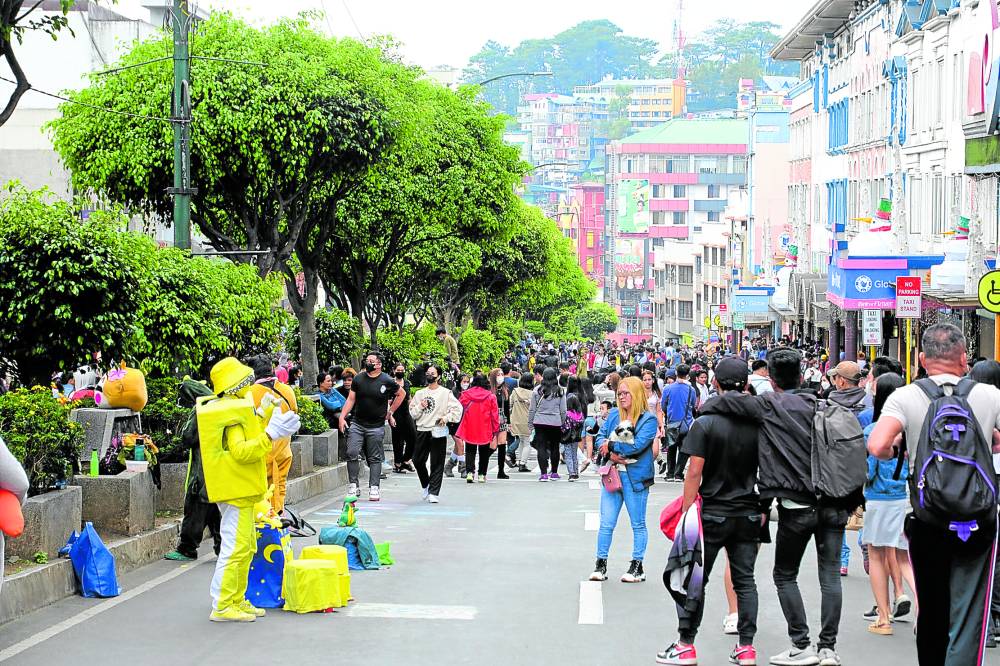Baguio sees ‘revenge travel’ to peak on flower fest

DOWNTOWN Session Road in Baguio City turns into a pedestrian mall every Sunday, such as this scene captured on Christmas Day last year, to give residents and tourists the opportunity to take leisurely walks, watch street performances, and check food and crafts stalls. —NEIL CLARK ONGCHANGCO
BAGUIO CITY — December 2022 drew an estimated half a million visitors to a chilly summer capital, and the continued influx of tourists since the start of this year meant Baguio may need to brace for huge crowds during the monthlong Panagbenga or Flower Festival celebrations in February, the city’s tourism officer said.
Aloysius Mapalo, at a press briefing on Wednesday, said they have yet to gather the booking records of over 900 Baguio accommodation establishments to provide a 2022 tally but the city’s experiences last year validated the phenomenon called “revenge travel” following the lifting of travel restrictions in mid-2022.
Tourists frequented Baguio even during the traditionally lean months of the year, noted Mapalo.
“[In 2022], we never had a lean season,” Mapalo said, because the buildup to a tourism surge started from June to September “as soon as Filipinos overcame the scare brought about by Omicron (a virulent mutation of COVID-19) in March.”
Baguio businesses used to follow a tourist trend that prepared hotels for huge numbers of visitors during the summer, followed by reduced operations during the monsoon months from June to September, Mapalo said.
Article continues after this advertisementWeekend visitors
The disappearance of lean tourist months may also be attributed to “weekend tourism,” a new travel behavior in which families drive up on Saturdays and Sundays to take in the sights before driving back to their hometowns, he said.
Article continues after this advertisementAccording to Mapalo, the return of the grand street dancing and float parades in this year’s staging of the Panagbenga would lure an “unusually high” number of guests who spread out during the weekends of February.
The influx of people to Baguio in 2022 was higher across the last 10 years, and gave the city’s tourism sector “much hope that economic recovery may come sooner than expected,” he said.
Baguio’s tourism-driven economy slumped to negative 17.1 percent growth in 2020 and rebounded to a 9.9 percent growth in 2021, records showed.
Gridlocks
However, the biggest inconvenience from high tourist volumes has been traffic jams and 30-minute gridlocks that left residents complaining.
Ironically, high traffic on the days leading up to the weekend has become a barometer of tourist behavior, Mapalo said.
“When we see traffic jams occur on Thursdays and Fridays, we expect many [more] tourists to drive up by Saturday or Sunday,” he said.
One of the surprise weekend attractions in Baguio has been the Sunday closure to vehicles of downtown Session Road, which allows people to gather or promenade along this stretch of road, Mapalo revealed.
He said weekend guests coming from neighboring towns come up on Sundays to enjoy the performances of buskers and cosplayers at Session Road.
The periodic closures generate traffic jams in the central business district and have been the subject of constant complaints.
But Mapalo said the pedestrianization of Session Road is part of the city government’s promotion of “micromobility,” like walking or biking, to discourage residents and even tourists from taking private vehicles downtown.
Feedback from local businesses indicated that a pedestrianized Session Road increased their walk-in customers, Mapalo said.